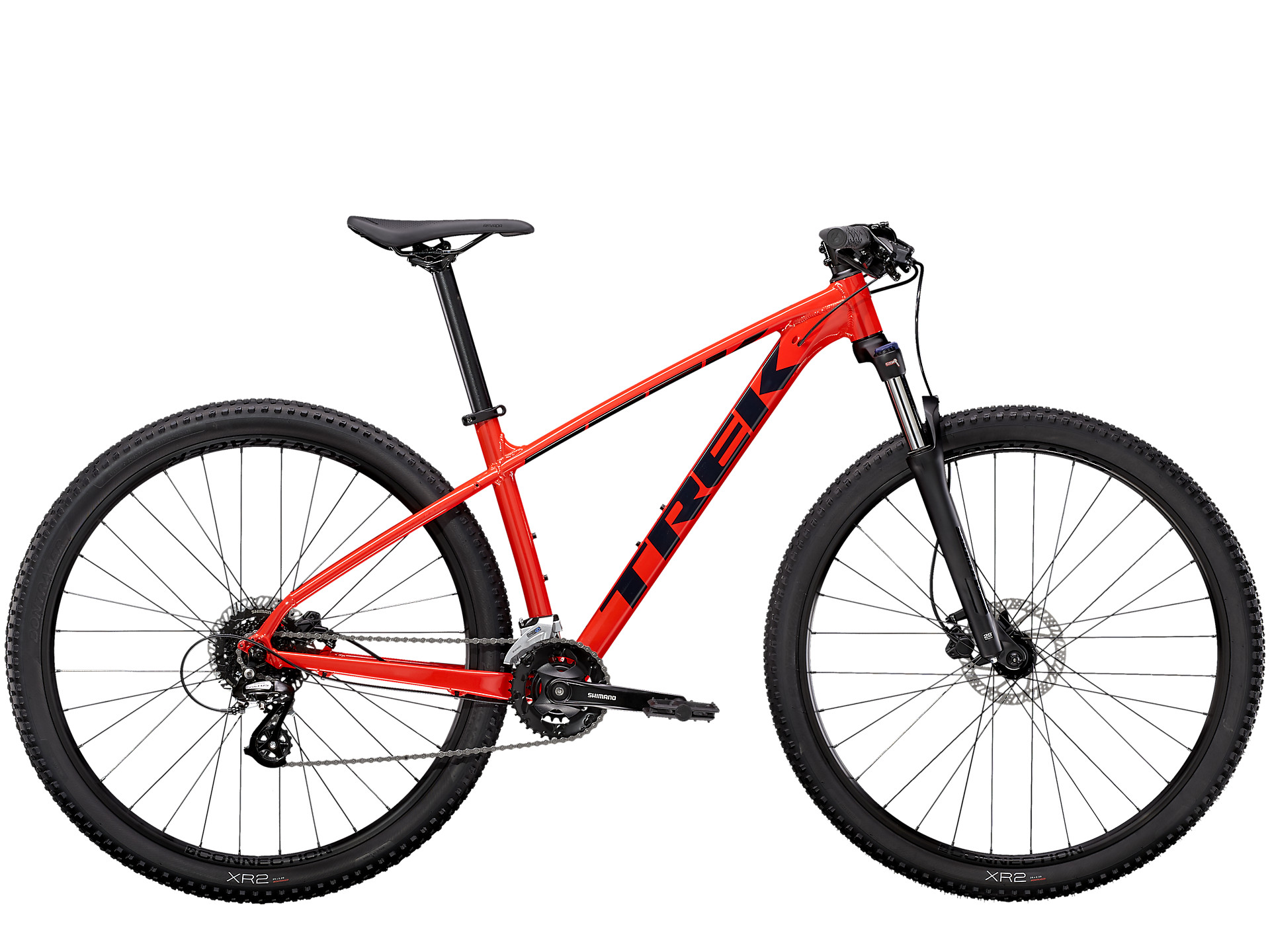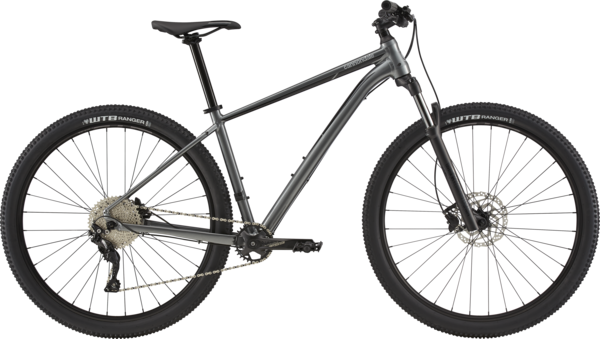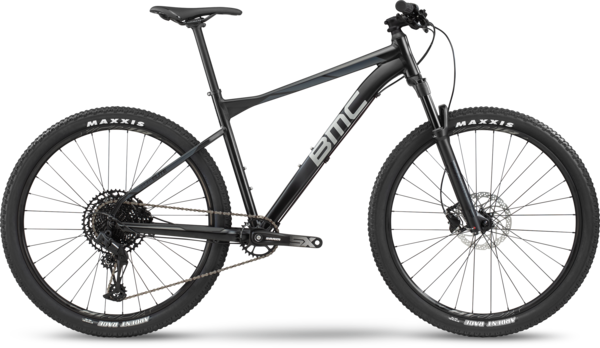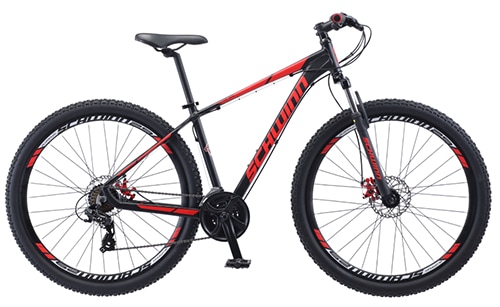

(Product prices are subject to changes and could be higher than the stated price range.)
First things first, I have to get this off my chest. My favorite type of mountain bikes out there are ones with full suspension. No Doubt.
That being said, it all comes down to a personal preference. Some of you adrenaline lovers out there prefer some extra bumps and shocks on the trail.
Full suspension mountain bikes have suspension on both wheels and hardtail bikes as the name suggests has a hard tail and suspension only in the front wheel. This is the main but not the only difference between the two types of mountain bikes.
Read on to find out more about the subtle differences and to find out the 9 best hardtail mountain bikes under $1000 out there.
Table of Contents
| Preview | Bike Model | Weight | Frame | Speed | Price | More Information |
|---|---|---|---|---|---|---|
| No products found. | No products found. | 40lbs (18kg) |
Aluminum | 24 | $439 | No products found. |
 |
Diamondback Overdrive | 30lbs (14kg) |
Butted Aluminum | 24 | $503 | CHECK PRICE |
| No products found. | No products found. | 37lbs (16.7kg) | Aluminum | 21 | $309 | No products found. |
 |
Trek Marlin 6 | 32lbs (14.5kg) | Aluminum | 16 | $649 | Check Price |
 |
Schwinn Bonafide | 39lbs (17.7kg) | Aluminum | 24 | $841 | CHECK PRICE |
 |
Co-op DRT 1.2 | 32.5lbs (14.7kg) | Aluminum | 18 | $949 | Check Price |
 |
GHOST Lanao 4.7 Women’s Bike 2019 | 31.9lbs (14.5kg) | Aluminum | 19 | $849 | Check Price |
 |
Cannondale Trail 4 | 31.5lbs (14.3kg) | Aluminum | 10 | $1000 | Check Price |
 |
BMC Sportelite 1 | 28.2lbs (12.8kg) | Butted Aluminum | 12 | $999 | Check Price |
No products found.
The Finiss by Merax is a compact, hardtail fork bike built from aluminum.
The aluminum frame is simple to construct and is streamlined and relatively tough. It can accommodate around 240lbs (109 kg).
The Merax finiss feels sleek and modern, with an angled top tube which seems to stretch from the handlebar all the way to the back wheel. To maximize longevity, the body is heat-treated.
The regular 26 "(66.04 cm) market standard wheels too are heat-treated and are crafted of a alloy that makes it both very solid and lightweight.
Another such unique highlight is the dual-walled rims that contribute to the wheel durability. Doubled fortified spokes are an incredible asset to MTB that take on mountainous terrain with some battering.
The forward suspension provides a lockout feature in aluminum which gives great command and a slicker adventure. The well-designed suspension with an 80 mm reach is very sensitive. All of these features mean that the rider is able to overcome obstacles and that there is less risk of an accident.
The manual disk brakes mounted at the front and are operated by Shimano aluminum levers
The bicycle uses components from Shimano tourney for the shifters and derailleurs. The Tourney set is the cheapest in the list of groupset, and at this cost is a given
PROS
CONS
I'm sure most of you recognize how genuine a diamondback product is. The diamondback label is highly respected in the biking community for those who don't know. High-end MTB bikes with diamond back can set you back at least $5000. Interestingly the 27.5-inch(68.84 cm) Overdrive is a true jewel.
The bike is definitely one of the best MTBs in this price bracket that you can purchase for the value of your cash. From the derailleurs, brakes and even the hardtail shock absorbers, the bicycle uses well known parts all round.
The compact frame is made of superior quality components and is noticeable on the fashionable bike with only one look. The aluminum butted alloy reduces the mass and adds resilience to the structure. It can endure terrain of any kind.
The frame also comes in 4 size – small (16”/40.64cm), Medium(18”/45.72cm), Large(20”/50.8cm) and an Extra Large (22”/55.88cm).
The 27.5 "(69.85 cm) wheels are a perfect balance as I described before among the 26-inch(66.04 cm) and 29ers (73.66 cm) tires. The wide wheels offer mobility and the capacity to quickly tackle any form of obstacle. Matched with Kenda Honey Badgers tires ensuring that the travel experience is easy and comfortable.
The bike ships with a SR Suntour suspension fork that is very normal with 80 mm range.
The bike comes with entry-level derailleurs and shifters from shimano that has 24 speeds. The brakes chosen are mechanical disk brakes from the Tektro and are incredibly powerful.
PROS
CONS
No products found.
The cheapest entry on our list only costs around $300 and is an excellent choice for all entry level riders. Keep your expectations low with this one.
It is a highly versatile bike and can be used as a commuter bike during the week and taken out for a fun yet mild trail bashing weekend. The bike consists of 26” tires along with a rather small frame and 21 gears.
The suspension system is okay and definitely subpar when compared to more expensive bikes on this list. It will do the bare minimum in absorbing shocks on your favorite trail. The brakes also do a pretty decent job and once again isn’t the best but is good enough.
The 26-inch tires are pretty standard in the MTB industry but the 2” tires are pretty concerning. Fatter the tires better the stability and control. Thin tires tend not to do well in rocky situations and are better suited for paved roads.
However, the frame is the only highlight of this bike and is the reason why it made on our list. The aluminum alloy is really strong for this price and will last long.
If you can master fundamental mountain biking skills in a bike like this, riding a bike with a higher price tag is going to be a cakewalk.
That being said, if you aren’t bankrupt and can spare another 100 dollars or so the Merax Finiss would be a better choice due to its Shimano components and heat-treated frame.
PROS
CONS
Can a best mountain bike list ever be complete without an entry from Trek? No way.
The marlin mountain bike series is an all-mountain type bike and is an amazing series of MTB bikes. The series continues to Marlin 7. Since most of the bikes on our feature lean towards the higher price range. We decided to include the Marlin 6 and not the 7 to balance it out.
The Marlin 6 costs around $649 and doesn’t differ that much when compared to the Marlin 7 which costs around $800+.
The Marlin 6 comes in both Men’s and Women’s options and is the same in terms of components but differs in frame geometry, colors, and sizes.
The Trek Marlin comes in 7 sizes for men and 4 sizes for women.
The aluminum frame looks so sleek and modern, I’d buy this bike just for the looks. The frame is also quite lightweight and has excellent geometry. The head tube angle is a comprise between steep and slack positions.
The Shimano Altus drivetrain is not completely entry-level and is a good fit for this price range. The bike offers 16 speeds so the gear changes are efficient and not confusing. Fewer components also mean lower weight.
The suspension is improved when compared to the Marlin 5 in terms of functionalities. The fork allows maximum travel of 100mm and has a preload and lockout function. Therefore, doubling this bike as a commuter bike is also possible.
PROS
CONS
The Bonafide is a flashy 29er with its red stripes on the charcoal black frame.
This bike could do better in terms of components for its price range.
The lightweight aluminum frame looks good and can take some beating before denting. The reason this bike made it on to our list is because of the 5-year warranty provided with the bike. This means you can use this bike for some time and not be afraid to hit the roughest lines and trails.
The 29-inch tires are paired with double-walled 2.25” knobby tires which are strong enough to do the job.
The front Schwinn suspension isn’t the best when compared to Suntour and other well-known forks, but it does absorb most of the shocks and tries its best to smooth out the ride for you.
The bike offers 24 speeds fitted with Shimano derailleurs and EZ-fire trigger shifters.
You’ll find mechanical disk brakes on the Bonafide which is a huge disappointment for this price range. Hydraulic brakes could have boosted the popularity and ratings of the Bonafide.
PROS
CONS
The DRT series is a Co-op cycles mountain bike range. This range is quite diverse and has a verity of bikes with different kinds of suspension to suit both beginners and experts.
All the bikes from here on are above $900 therefore let’s see how the bikes meet our high expectations.
The DRT 1.2 costs $949 which is 400 dollars higher than the entry-level DRT 1.1. That’s quite a steep increase in price.
The DRT 1.2 is also offered in a women’s edition 1.2W which is cheaper than the DRT 1.2 and differs in terms of geometry and components unlike the TREK Marlin 6. The tires are on the 1.2W are smaller in terms of size and width. The 1.2W offers 27 gears while the men’s version only offers 18 speeds.
The DRT 1.2 doesn’t look good as most of the DRT series but makes up for it in terms of components and performance. The bike consists of components from Shimano Acera, Deore, Altus, and Alivio groupset.
The Suntour front fork allows maximum travel of 120mm which is the highest we’ve seen so far on this list. As you develop your mountain bike skills and hit rough trails with massive drops, you’ll appreciate that extra 20mm of travel when compared to the standard 100mm in this price range.
The 18 speed is perfect for riders who have some experience and doesn’t require that much assistance for climbs.
PROS
CONS
No products found.
The Lanao series by Ghost is a hardtail lineup tailored for women who are just getting into the sport.
The bike is beautifully designed to accommodate women’s anatomy from the dropper-post compatibility to the top tube angles. The low standover height aluminum frame can take a fair amount of beating and is easy to control.
The Lanao 4.7 costs $849 and is a great option for beginners as well as intermediate riders due to the quality components used.
The bike offers 18 speeds with a 2x9 setup. The Front derailleurs used are from the Shimano ACERA groupset which is a decent choice and is paired with rear derailleurs from the Shimano Deore series which is an excellent choice for a bike of this price.
The number of gears might not be sufficient for some beginners who aren’t in a good shape and require extra assistance, especially during climbs.
The Suntour XCM fork is an entry-level fork with a 100mm travel and lockout function which is very useful.
The Continental X-King tires used are quite pricey but a solid choice due to its lightweight. The 27.5” tires will provide a good amount of traction and speed. The wheels are connected to Shimano MT200 Hydraulic brakes which have remarkable modulation and are controlled by Shimano Brake levers.
PROS
CONS
An MTB list wouldn’t be complete without an entry from Cannondale.
At number 8, the Trail 4 is the most expensive bike on our list right at the border of our price range.
Cannondale is quite popular for its reverse sequence. Therefore, the Trail 8 is the most basic bike in the Trail series with the Trail 1 costing around $1850.
Everything about this bike is amazing. Starting from the frame to the components used.
The Trail 4 uses the Cannondale inhouse C2 SmartForm frame. This is their mid-level frame just below the C1 and C1 premium. It is lightweight and quite strong due to the innovative SAVE technology used by Cannondale where the thickness of the tubes is increased where necessary but skinny elsewhere.
The bike only has a rear derailleur from the Deore groupset and has a 1x10 setup. Shifting is pretty fast and efficient but this bike is not for beginners who lack leg power and require extra assistance from a higher number of gears.
The first bike on our list with a RockShox suspension fork. It is not the best fork out there but with a 100mm travel, lockout, and rebound feature it is not the worst either.
Wheel size varies on the frame sizes. The smaller sizes roll out with a 27.5” tire while the larger frame sizes sport 29ers. All sizes use the 2.25” tubeless WTB STX i23 TCS. The wheels are linked to Shimano MT200 hydraulic brakes.
PROS
CONS
Finally, a bike that uses SRAM components instead of Shimano.
The Sportelite One by BMC is a dollar cheaper than the most expensive bike on our list.
The bike is quite light due to its butted hydroformed aluminum frame. It is the lightest bike on our list at 28.2lbs (12.8kg). Lightweight doesn’t mean weak, the frame is butted and is quite strong. The smaller sizes of the bike can also be used by kids due to its lightweight.
The suspension fork used is the SRAM RockShox 30s TK which has 100mm travel. The spring coil fork is an entry-level one and is not the best out there. The Sportelite one could have done better.
The bike offers 12 speeds with the SRAM SX Eagle Rear derailleur which is part of the cheap SRAM SX Eagle groupset and again the Sportelite could do better.
The brakes and hubs used are from the Shimano collection.
PROS
CONS
If you’re a competitive rider, any type of mountain bike under $1000 is not for you.
Mountain bikes below $1000 are ideal for amateurs who’ve got a bit of experience or for beginners who aren’t strapped for cash.
A rookie is described as anyone who has just gotten into MTB biking and sometimes hits the hills a few times every week.
A perfect bicycle for a rookie should have an alloy framework along with parts that are at the lowest tier of the group set spectrum such as Shimano Acera, a minimum of 75-100mm suspension travel, 21+ speeds, and disk brakes.
Related Posts:
For our amateur readers, MTB is a broad classification of bikes and can be broken down into 5 types.
Each of these bikes has a different purpose.
Fat Tire Bikes aren't as nimble as other groups of mountain bicycles, but these fatties can take you across almost any landscape. Tires larger than 3.7” broad area known as fat tire cycles. These tires may take on vibrations, but they're not the similar to suspension I’m going to get to that later.
The most popular mountain bikes are the Trail Bikes. Regarded all-rounders, in almost any kind of terrain, those bikes work well. Trail bicycles are extremely durable and very effective
Cross Country bikes are suitable for our pace lovers. CC bikes also very robust, similar to trail bicycles but are designed with pace and improved climbing strength in consideration. They are typically lighter and varying in shape to trail bikes.
All-Mountain Bikes are highly powerful bicycles for all-terrain, with greater technical functionality.
Enduro/Downhill Bikes are Optimal for the ruggedest and most difficult terrain. These need more handling experience. Such bikes are used by MTB riders for descent challenges. The enhanced suspension helps race downhill at faster speeds.
In terms of shape and parts, each of these bicycles has more technical variations that I haven't discussed in depth. Yet as a newbie or amateur, a trail or all-mountain bike is an optimal choice.

MTB suspension can be broken down into three main types
Full Suspension: Such types of bicycles have suspension in their fore and rear tires as you might probably recognize from the name itself. Better convenience comes with a significant cost and steep maintenance cost.
Hardtail Suspension: Typically, popular in this budget, only the forward wheel has any suspension form while the back is rigid, thus the hard-'tail' name. Upkeep is very minimal and optimally, the front suspension would have the feature of a lock to prevent a rough ride on softer terrain.
Rigid Suspension: No suspension at all is the least expensive suspension option. For rugged terrain, these types aren't recommended.
Since this article is about hard-tail bikes, read on to find out the difference between full suspension and hardtail bikes and which is type is perfect for you.
Most MTBs are built of aluminum alloys, and carbon fiber frames are uncommon, particularly at this budget.
Particularly when butted, aluminum is light and yet relatively durable. Aluminum is also rust-resistant, and you'll be able to make use of your aluminum body for quite some time with regular care.
Steel is very bulky and ineffective when in the context of mountain biking.
Carbon fiber is the lightest, but it can fracture if damaged instead of a dent.
Trying a bicycle to find the best fit is often advised, since sometimes the sizing charts may be inaccurate.
When you choose to shop online and you're stuck in choosing between 2 sizes, always go for the larger size, and with a few changes you can make a bigger framework feel smaller quickly than getting a little bike to feel larger
Owing to variations in design, people should also choose suitable bikes according to genders. Women's bicycles are produced with designs such as a short top tube and other features to suit the female body.
However, many bicycles are made today with both men and women in mind and can be appreciated by people of both genders
The only choice was 26-inch (66.04 cm) tires when mountain bicycles first happened to come out, but today you could pick among 27.5-inch (69.85 cm) and 29-inch (73.66cm), generally identified as 29ers.
Wheel size is important and it’s a compromise between performance and agility. Wheels with larger diameters can effortlessly overcome any form of obstruction, wheels with lower diameters are very versatile.
For quite a long a time the 26” (66.04 cm) wheel was the production norm. They're perfect for veterans and also amateur riders as they have improved bike control.
Most riders still choose 27.5” (69.85 cm) wheels as it lies between the two ends. You're sort of getting the finest of the two. Better effectiveness than the 26-inch (66.04 cm) and more agility than the 29er
29-inch wheels combine some considerable weight to the bicycle but can effortlessly prevail over any type of hurdle or surface.
In this budget range, including Shimano Tourney up to Deore or SRAM X3/X4, is expected.
The low tier groupset is utilized for light usage, while upwards through the hierarchy such as Shimano XTR or SRAM XX1 are used for racers or by seasoned intense riders.
You will typically get 21 or 24 gears on inexpensive bicycles whereas more expensive bicycles generally have fewer gears. 21 or 24 gears indicate that the bicycle has a triple front chainring with rear cassettes of either 7 or 8 gears. Ideally, a mountain bike front chainring should have a 42/34/24 T setup
Hydraulic brakes are expected to be found on most bicycles within this budget range with occasional exceptions of mechanical disk brakes on the cheaper models.
Apart from the difference in suspension, both these types of bikes have subtle differences.
I believe everyone looking to get into mountain biking should learn the ways of the trail with a hardtail. Sure, full-suspension gives you better control of your bike, better traction, easier corners, and much more but essentially you are cheating yourself. Fundamental skills are not learned by entry-level riders who hop onto a full suspension bike straight away.
Without the rear suspension, hardtails bikes teach riders how to control the bike with their hands and how to smooth out the shocks using their legs.
It teaches riders to read their trail well and pick the right line. Hardtail teaches cool skills such as how to bunnyhop correctly.
Also, Hardtails are considered badass. Nothing boosts your ego like riding your favorite rough line with a hardtail.
Less components means lower weight, right?
This is true but also largely depends on the type of frame material. But in general, full-suspension bikes weigh more due to the suspension in the back and all the extra components such as tubes and pivots.
Hardtails are generally cheaper than full-suspension bikes.
Just like the weight other factors such as weight, components, etc. contribute to the price of a bike. But rest assured you can always buy a high-quality hardtail for the same price as a full suspension with lower quality components.
Compared to a full-suspension bike, a hardtail is better in terms of versatility. It is the better option if you plan on using your mountain bike as your commuter bike as well.
If your full suspension lacks a lockout feature, you’re going to be bouncing around extra on paved roads when compared to a hardtail.
Unlike the cost and weight, this is 100% guaranteed.
Just like less component might mean less weight, it also implies less maintenance for sure.
Each suspension shock absorber needs to be maintained at least once every year. Pivot bearing is also quite costly. Isn’t it better to service one shock absorber than service two?
Hardtails are also quite easy to clean with less moving parts and components.
Since there is a wide range of hardtail mountain bikes below $1000, it is always recommended to stick towards the higher end for better features. However, bikes like Diamondback Overdrive are exceptions to this recommendation.
Hardtail bikes are badass, and you can earn your bragging rights when you tell your friends that you just hit the roughest trail with your hardtail.
